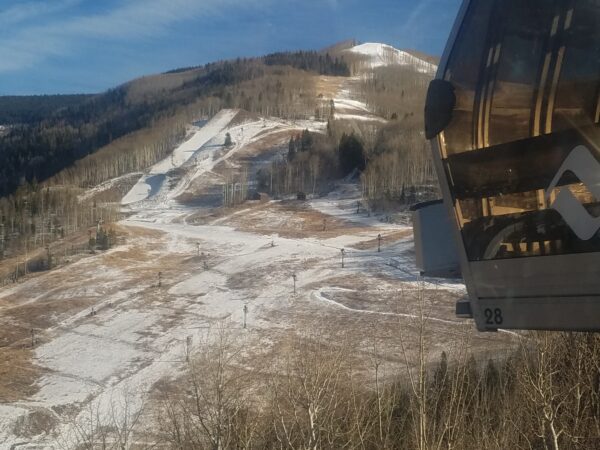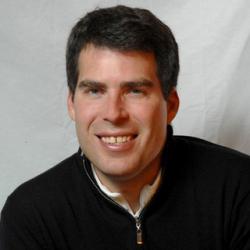Debating snowmaking, cloud seeding for skiing during worsening climate crisis

Looking up at the grassy, brown lower slopes of Colorado ski resorts these days, streaked in places with patches of artificial snow, it’s natural to wonder, what’s the point?
As the aridification of Colorado accelerates due to manmade climate change (Denver recently blew past its all-time record for latest measurable snowfall), manmade mountain snow through snow guns or cloudseeding seems like an extravagance a drought-stricken state can ill afford, some observers say.
The “race” to open first for the 2021-22 ski season was won weeks ago by Wolf Creek in southern Colorado, driving the stoke machine of marketing that produces early-season pass sales and trip bookings.
But now Thanksgiving has come and gone and some resorts such as Beaver Creek and Steamboat had to delay their opening days due to a very warm, dry fall, and others, such as Aspen, Vail and Snowmass, opened with very limited skiable terrain.
Vail managed to get a couple of lifts running by Nov. 12, but snow riders had to download the lower mountain on a gondola for two weeks because it was too warm for snowmaking on the lower stretches. It now has top-to-bottom skiing on a cat road.
All of this begs the question, why not just wait on Mother Nature and open for the season when she allows it with some natural snow or at least temperatures lower than the 40s and 50s Fahrenheit?
One of the biggest reasons is green – as in there’s a lot of money to be made by blowing snow and hyping the ski season ahead of Thanksgiving.
According to a study by Boulder-based RRC Associates, “Colorado’s ski industry generates $4.8 billion in annual economic output, supports more than 46,000 year-round equivalent jobs, and generates $1.9 billion per year in labor income within Colorado.” And much of that revenue comes before Labor Day in the form of Ikon and Epic Pass sales.
Soon thereafter, snow guns start cranking up and pasting ski trails, especially at the higher elevations of Summit County, with manmade snow, as Arapahoe Basin, Loveland and Keystone jockey to be the first in the nation to welcome skiers.
“Oh, I’ve always thought that arms race around early opening or early-season [ski] races was madness,” said Auden Schendler, senior vice president of sustainability at Aspen Skiing Company. “But you also need to know that these economies are still driven by skiing — you don’t have that engine going without snow, you just have people staying in hotels and going to restaurants — and most resorts have not created a similar year-round economy around mountain biking. But you could do winter way more efficiently, even while making snow, if you said: ‘We’ll open around Dec. 1.’”
Aspen and Snowmass opened for the season on Thanksgiving with a mere 57 acres of skiable terrain. And while Vail Resorts’ Beaver Creek Resort opened to the public on Monday (barely), it recently announced enough snowmaking up high to host its annual Birds of Prey World Cup races Dec. 3-5, with an added downhill now on Thursday, Dec. 2.
With a dearth of natural snow so far this season and daytime temps in the 40s and 50s, snowmaking has been mostly limited to nighttime production, and even that’s been tough at lower elevations like Vail’s Golden Peak (just over 7,000 feet).
The ideal temperature for snowmaking is in the 20s — with low humidity that drops the overall “wet-bulb” temperature. Colorado has not been seeing those conditions this month.
But Vail Resorts Sustainability Director Kate Wilson dispels the notion of an arms race to open first and reap marketing benefits.
“This isn’t about being the first to open; it’s about providing a more consistent early season to our pass holders,” Wilson said. “Our innovative snowmaking technology allows us to do this earlier in the season at Keystone because of its elevation, but in places like Vail, it’s about more consistent opening conditions.”
Global greenhouse gas emissions pose a direct threat to Colorado ski towns, ranging from “diminished snowpack to a greater reliance on energy-intensive snowmaking using increasingly restricted water resources,” according to Dr. Keith Musselman, a member of Protect Our Winter’s Science Alliance and a hydrologist at the University of Colorado who studies the state’s snowpack.
Most snowmaking water winds up back in the drainages it comes from during spring runoff (with only about 10% lost to evaporation), and Wilson says that new snowmaking technology is extremely energy efficient.
“At Vail Mountain, our snowmaking enhancement uses technology that reduced energy and water usage, and creates a more consistent surface at our higher elevations,” Wilson said. “This revolutionary technology uses software to monitor the weather at our snow guns and automates much of the process.”
The new snow guns at Vail reduce snowmaking energy by 85%, Wilson added, calling snowmaking “largely non-consumptive.” Vail recently joined other ski companies in forming the Climate Collaborative, and has achieved 85% renewable electricity.
Last season, however, the company that owns Vail, Beaver Creek, Breckenridge, Crested Butte and Keystone in Colorado, faced some criticism for pulling out of cloud seeding operations after four decades of funding. The technique of firing silver iodide crystals into passing snowstorms to increase productivity has shown some signs of improving the state’s snowpack.
“We don’t currently have anything to share here, but if anything changes, we’ll let you know,” Wilson said when asked if the company might revisit the program.
Vail’s competition, at least, doesn’t think it’s worth it.
‘Personally, I think it’s a waste of money, and it’s hard to know if it’s effective — the wind changes, it doesn’t work,” Aspen Skiing’s Schendler said. “I’m also not a fan of messing with natural systems. As I understand it, the level of impact is small, and could in no way relate to the 100 inches decrease [in Colorado snowfall] last year. Could we please stop using Band Aids and try to do something big, real, and good for the world by meaningfully tackling climate change?”
POW’s Musselman agrees: “To me, cloud seeding seems to be a grasping-at-straws approach that is admittedly easier but undoubtedly less effective than addressing the issues head-on via conversation and bi-partisan policy and infrastructure discussions.”
Editor’s note: This story first appeared on Colorado Times Recorder.


Latest posts by David O. Williams (see all)
- During National Small Business Month, Target, DreamSpring put funding bullseye on underrepresented communities in Denver area - May 29, 2025
- Colorado senator urges Supreme Court to hold Trump administration in contempt on deportations - April 19, 2025
- Conductor who brought back Colorado ski train wants to use rail to save state’s highways for skiing - March 20, 2025

You must be logged in to post a comment Login